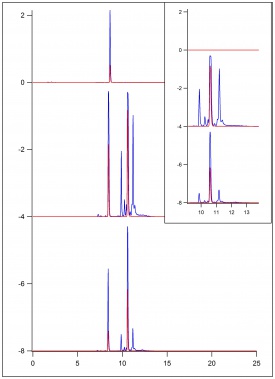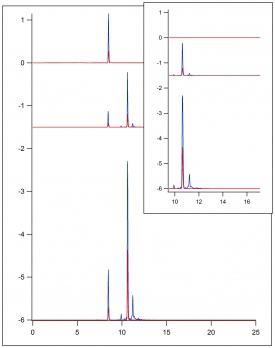Difference between revisions of "Synthesis of Lignin Monomers"
| Line 42: | Line 42: | ||
Figure 1 displays the results of HPLC testing that was run on 4 separate samples. The first is the ferulic acid standard. The second is a sample of the final product from the first attempt at the esterfication of ferulic acid. The third is a more dilute sample of the samp sample from the second graph. The final graph represents the sample of the reflux intermediate from the second attempt at the esterfication process. All samples were run using the acquisition method: pCou_100417_SAZT. | Figure 1 displays the results of HPLC testing that was run on 4 separate samples. The first is the ferulic acid standard. The second is a sample of the final product from the first attempt at the esterfication of ferulic acid. The third is a more dilute sample of the samp sample from the second graph. The final graph represents the sample of the reflux intermediate from the second attempt at the esterfication process. All samples were run using the acquisition method: pCou_100417_SAZT. | ||
| + | Figure 2 displays the results oif HPLC testing that was run on 3 separate samples. The first is the ferulic acid standard. The second is the sample of the reflux intermediate from the second attempt at esterfication of ferulic acid after one and a half days of reflux. The third graph is the results from a sample of the final product, indicating the esterfication of ferulic acid to ethyl ferulate. All samples were run using the acquisition method: pCou_100417_SAZT. | ||
[[File:Fa etfa reflux.jpg|275px|thumb|left|Figure 1: HPLC Results after esterfication of Ferulic Acid]] | [[File:Fa etfa reflux.jpg|275px|thumb|left|Figure 1: HPLC Results after esterfication of Ferulic Acid]] | ||
[[File:ETFA2 06 22 22.jpg|275px|thumb|center|Figure 2: HPLC Results after second attempt at esterfication of Ferulic Acid]] | [[File:ETFA2 06 22 22.jpg|275px|thumb|center|Figure 2: HPLC Results after second attempt at esterfication of Ferulic Acid]] | ||
| − | |||
==Discussion== | ==Discussion== | ||
Revision as of 16:23, 22 June 2018
Motivation
Introduction
Lignin is the second most abundant organic polymer. It is found in plants, majorly in trees. Its function is to serve in the assistance of water flow throughout the plant. It forms a barrier for the evaporation, trapping the water inside.
The structure of lignin is composed of the seemingly random combination of three monomers: p-coumaryl alcohol, coniferyl alcohol, and sinapyl alcohol.
FIX THE LINKS IN THIS PARAGRAPH
These lignin monomers are derived from their acid precursors through the reduction of an aldehyde to the corresponding alcohol. While the acid precursors,p-courmaric acid (p-coumaryl alcohol), ferulic acid (coniferyl alcohol), and sinapic acid (sinapyl alcohol) may not be as abundant in nature, when it comes to the lab setting, these chemicals are easier to come by then their alcohol forms. The synthesis of theses alcohols can save a research space a great deal of money, if experiments require the alcohol forms of these monomers.
Materials
Diisobutylaluminum hydride solution (25 wt.% in toluene)
Product Number: 192724-100G
Quantity: 2
Price: $52.20
Toluene (Anhydrous, 99.8%)
Product Number: 244511-1L
Quantity: 1
Price: $60.50
Experimental
The esterfication of ferlic acid was the first step in the reduction of ferulic acid to coniferyl alcohol. First attempt was made using a 0.24M solution of ferulic acid in ethanol (250 mL ethanol, 12.1g ferulic acid). Along with 3 drops of concentrated HCl this was allowed to reflux for two days. The resulting solution was evaporated at low pressure, leaving a solid. This solid was then resolubilized in ethyl acetate (250 mL) and rinsed with sodium bicarbonate (2x100 mL) and brine (50 mL). The solution was dried using magnesium sulfate and evaporated at low pressure, resulting in an oil like solution. The final product was testing in the HPlc (Figure 1).
A second attempt at the esterfication of ferukic acid was carried out using the same method as above, but on a 1/5 scale. An HPLC was done of the intermediate that is present after 1 day of refluxing (Figure 1).
Results
Figure 1 displays the results of HPLC testing that was run on 4 separate samples. The first is the ferulic acid standard. The second is a sample of the final product from the first attempt at the esterfication of ferulic acid. The third is a more dilute sample of the samp sample from the second graph. The final graph represents the sample of the reflux intermediate from the second attempt at the esterfication process. All samples were run using the acquisition method: pCou_100417_SAZT. Figure 2 displays the results oif HPLC testing that was run on 3 separate samples. The first is the ferulic acid standard. The second is the sample of the reflux intermediate from the second attempt at esterfication of ferulic acid after one and a half days of reflux. The third graph is the results from a sample of the final product, indicating the esterfication of ferulic acid to ethyl ferulate. All samples were run using the acquisition method: pCou_100417_SAZT.
Discussion
References
Lignin Biosynthesis and Structure
[Overview from Lignin and Lignans: Advances in Chemistry]
Facile Large-Scale Synthesis of Coniferyl, Sinapyl, and p-Coumaryl Alcohol


